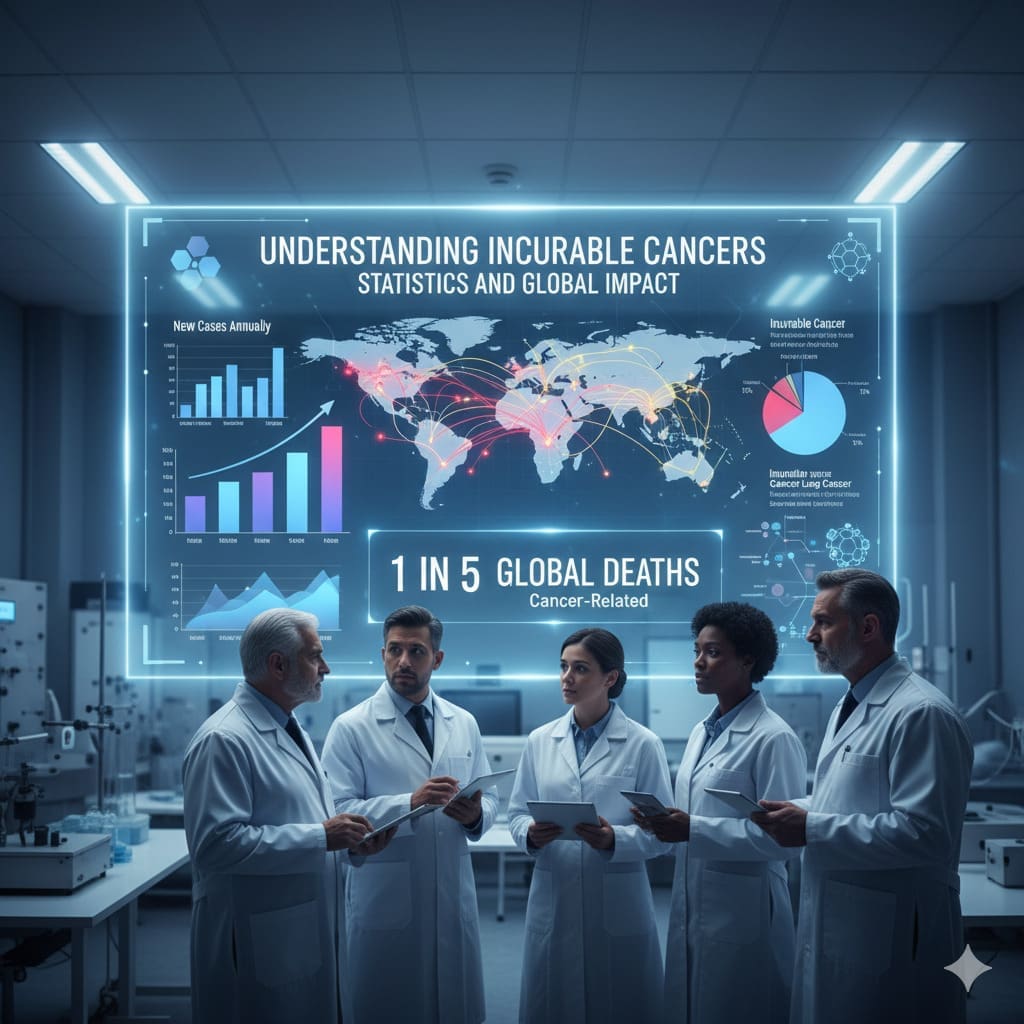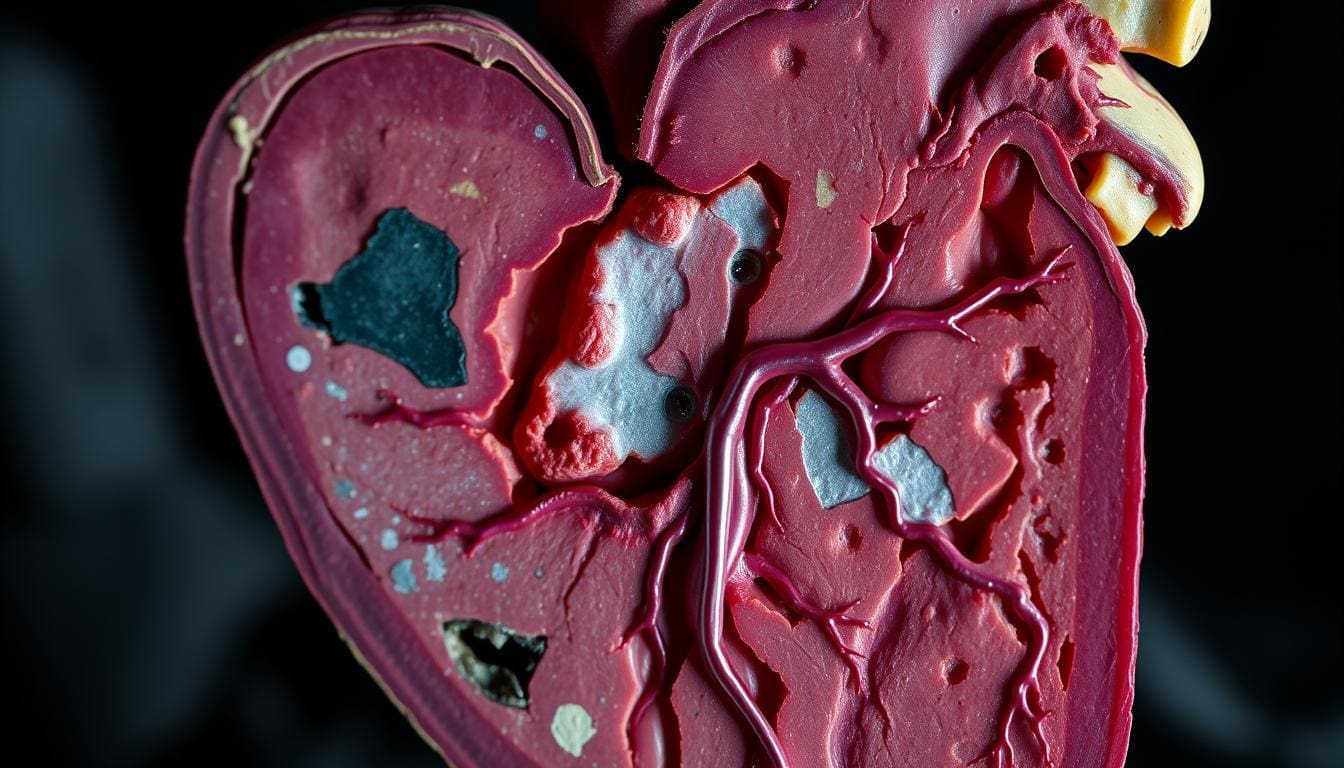Last Updated on November 26, 2025 by Bilal Hasdemir

Getting a diagnosis of an aggressive cancer is very tough. It leaves patients and their families with many questions. At Liv Hospital, we focus on giving full care and support to those with the toughest cancers. We will look at the top 10 deadliest forms of cancer, their effects on patients, and the latest in treatments.
Cancers like pancreatic, lung, and glioblastoma multiforme have high death rates and few treatment choices. We will dive into the advanced treatments and palliative care services available. For example, early detection is key in prostate cancer. It can greatly improve treatment results, as seen in Grant Aldred’s story. He was diagnosed at 56 and thinks early detection could have changed his treatment outcomes.
Key Takeaways
- Understanding the deadliest forms of cancer is key for patients and doctors.
- Advanced treatments and palliative care are vital for patient care.
- Early detection and diagnosis greatly affect treatment success.
- Liv Hospital is dedicated to giving full care to international patients.
- Personalized care and support are critical for those with aggressive cancers.
What Makes Certain Cancers Incurable
Certain cancers are called incurable for many reasons. These include late diagnosis and treatment resistance. Knowing these reasons helps us find better ways to support and care for patients.
Defining Characteristics of Treatment-Resistant Malignancies
Cancers that are hard to treat grow fast and spread quickly. They often don’t respond well to common treatments. This makes it hard to shrink the tumors or stop the cancer from spreading.
The aggressive nature of these cancers comes from specific genetic changes. These changes make cancer cells less likely to respond to treatments like chemotherapy or targeted therapies.
Common Factors in Poor Prognosis Cancers
Being diagnosed late is a big problem for some cancers. Cancers like pancreatic cancer often don’t show symptoms early. This means they are usually found when they are more advanced.
Another big issue is that current treatments don’t work well for advanced cancers. Even with research breakthroughs, many patients with incurable cancers have few treatment options. Clinical trials might offer new treatments, but getting into them can be hard.
It’s important to support patients with incurable cancers well. This means focusing on their quality of life, not just treating the cancer. Helping patients cope and providing full support can make a big difference in their lives.
We need to keep funding cancer research to find new treatments. Understanding why some cancers don’t respond to treatment is key. This knowledge will help us create better therapies and fight incurable cancers more effectively.
Understanding Incurable Cancers: Statistics and Global Impact
Incurable cancers are a big problem worldwide. They have high death rates and few treatment options. It’s important to know their numbers and how they affect us globally.
Mortality Rates and Survival Statistics
The death rates for incurable cancers are very high. For example, pancreatic cancer has a five-year survival rate of under 10%. Lung cancer and glioblastoma have survival rates of under 20% and 10%, respectively. These numbers show how serious these cancers are and why we need to find them early and treat them well.
Every year, millions of new cancer cases are reported worldwide. Incurable cancers affect many people. The rates of getting and dying from these cancers vary based on where you live, your lifestyle, and your access to healthcare.
Risk Factors and Prevention Possibilities
Knowing what increases the risk of getting incurable cancers is key to preventing them. For instance, smoking greatly increases the risk of lung cancer. Some genetic mutations also raise the risk of pancreatic cancer and glioblastoma. By knowing these risks, we can try to lower the number of new cases through better health education and campaigns.
New discoveries in cancer research have helped manage symptoms and improve care for those with terminal illnesses. Good palliative care is essential. It helps patients with incurable cancers live better by taking care of their physical, emotional, and social needs.
We must keep working to beat incurable cancers. By pushing for more research and better care, we can lessen their impact worldwide. This way, we can improve the lives of those dealing with these diseases.
Pancreatic Cancer: The Silent Killer
Pancreatic cancer is known for its vague symptoms, leading to late diagnosis and few treatment choices. It’s called a “silent killer” because it often goes unnoticed until it’s too late.
Why Early Detection Is Rare
Finding pancreatic cancer early is hard because its symptoms are not clear. Symptoms like stomach pain, weight loss, and yellow skin can mean many things. This makes it tough to spot pancreatic cancer early.
There’s no good test for pancreatic cancer yet, unlike for other cancers. Scientists are working hard to find new ways to catch it sooner.
Treatment Limitations and Challenges
Most pancreatic cancers are found too late, which limits treatment choices. Surgery is the only chance for a cure, but it’s only for a few patients.
For those with late-stage cancer, treatment aims to ease symptoms and improve life quality. Advanced treatment options include chemo, radiation, and targeted therapy. These can help but can’t cure the disease.
“The majority of pancreatic cancer patients are diagnosed at a stage where curative surgery is not possible, highlighting the need for more effective early detection methods and innovative treatments.”
Current Research Directions
Research on pancreatic cancer is focused on better detection, treatments, and understanding the disease. Clinical trials are key, giving patients new therapies.
- Looking into new treatments and targets.
- Improving surgery and care after surgery.
- Enhancing palliative care services for advanced disease patients.
By learning more about pancreatic cancer and finding better treatments, we aim to help patients more.
Glioblastoma Multiforme: Aggressive Brain Malignancy
Glioblastoma multiforme is one of the deadliest brain cancers. It grows fast and doesn’t respond well to common treatments. This makes it hard to treat and care for patients.
Blood-Brain Barrier Treatment Challenges
The blood-brain barrier (BBB) is a big problem in treating glioblastoma multiforme. It keeps out many drugs but also stops them from reaching the tumor. We’re working on new ways to get drugs past the BBB, like:
- Creating drugs that can get through the BBB
- Using focused ultrasound to open the BBB temporarily
- Using nanoparticles to carry drugs directly to the tumor
These new methods aim to get drugs to the tumor better, making treatments more effective.
Standard Protocols and Their Effectiveness
The usual treatment for glioblastoma multiforme includes surgery, radiation, and chemotherapy. Even with these strong treatments, the outlook is not good. Most people live about 15 months after being diagnosed. We’re always looking to improve treatment plans to help patients live longer and better.
Key parts of standard treatment are:
- Removing as much of the tumor as possible
- Using radiation to kill any remaining cancer cells
- Chemotherapy with temozolomide
These treatments can help people live longer and feel better. But, we really need new, better treatments.
Neurological Impact and Quality of Life
Glioblastoma multiforme affects patients’ brains and their quality of life. It can cause problems like memory loss, seizures, and trouble moving. We’re working hard to support patients, including helping them cope and improving their life quality.
Supporting patients and their families is key. This includes:
- Palliative care to manage symptoms and pain
- Psychological support to deal with the diagnosis and treatment
- Rehabilitation to keep patients as functional as possible
By focusing on the needs of glioblastoma patients, we can make their lives better and provide full care.
Lung Cancer: Leading Cause of Cancer Deaths
Lung cancer is a major global health issue, leading to the most cancer deaths worldwide. We will look into lung cancer’s complexities, including its types, diagnosis challenges, and treatment resistance.
Types of Lung Cancer
Lung cancer is mainly split into two types: Small Cell Lung Cancer (SCLC) and Non-Small Cell Lung Cancer (NSCLC). NSCLC makes up about 85% of cases and includes subtypes like adenocarcinoma and squamous cell carcinoma. SCLC is more aggressive and linked to smoking.
Small Cell vs. Non-Small Cell Variants
- Non-Small Cell Lung Cancer (NSCLC): More common, with subtypes that vary in aggressiveness and treatment response.
- Small Cell Lung Cancer (SCLC): Less common but more aggressive, with a strong association with smoking.
Challenges in Diagnosis
Lung cancer is often diagnosed late due to a lack of early symptoms and limited screening methods. Most patients are diagnosed when the disease is advanced, making treatment harder.
Reasons for Late-Stage Diagnosis
- Lack of specific early symptoms.
- Limited effectiveness of current screening methods for early detection.
- High risk in certain populations, such as smokers.
Treatment Resistance Mechanisms
Overcoming lung cancer treatment resistance is a big challenge. Various mechanisms, like genetic mutations and the tumor microenvironment, play a role. Understanding these is key to developing better treatments.
| Mechanism | Description | Impact on Treatment |
|---|---|---|
| EGFR Mutation | Genetic mutation affecting tumor growth. | Resistance to certain targeted therapies. |
| Tumor Microenvironment | The environment surrounding the tumor. | Influences treatment response and resistance. |
We are working hard to improve lung cancer understanding and treatment. By exploring new oncology advancements and learning about treatment resistance, we aim to better manage symptoms and care for patients with terminal illness.
Liver Cancer: Rising Global Threat
Liver cancer is becoming a big problem worldwide. It’s linked to liver conditions. Cases are going up because of hepatitis B and C, alcohol, and fatty liver disease.
Underlying Liver Disease Connection
Liver cancer often starts with liver disease, like cirrhosis. Cirrhosis scars the liver from chronic inflammation. This raises the risk of liver cancer.
Managing liver cancer means tackling the liver issues that cause it. The connection between liver cancer and disease is complex. Chronic inflammation and cirrhosis can cause cancer by changing liver cells’ genes.
Treatment Options and Limitations
There are many ways to treat liver cancer, like surgery and targeted therapy. But, these treatments work best if caught early and the liver is healthy.
For advanced liver cancer, palliative care services help improve life quality. They manage symptoms and pain. Clinical trials also offer new treatments, giving hope to those with few options.
Geographic Distribution and Risk Factors
Liver cancer varies by region, with East Asia and sub-Saharan Africa seeing more cases. These areas have high rates of hepatitis B and C, big risk factors.
Other risks like alcohol, obesity, and aflatoxin also play a part. Knowing these risks helps in creating better prevention plans and improving health outcomes.
Ovarian Cancer: The “Silent Disease”
Ovarian cancer is often called a “silent disease” because it’s hard to catch early and often comes back. We’ll look into why it’s tough to find early, why it often comes back, and how genes play a part.
Challenges in Early Detection
Finding ovarian cancer early is hard because its symptoms are not clear. These symptoms can be mistaken for other, less serious problems.
Common symptoms include bloating, pelvic pain, and trouble eating. But these signs are often mild and can be confused with other issues.
| Symptom | Common Misdiagnosis | Impact on Diagnosis |
|---|---|---|
| Bloating | Gastrointestinal issues | Delayed diagnosis |
| Pelvic pain | Menstrual cramps or endometriosis | Lack of immediate investigation |
| Difficulty eating | Gastrointestinal disorders | Failure to suspect ovarian cancer |
Recurrence Patterns and Treatment Resistance
Ovarian cancer often comes back, and it can resist treatments. Knowing how it comes back is key to finding better ways to treat it.
“The high recurrence rate of ovarian cancer highlights the need for better first treatments and follow-up care to manage recurrence.”
Scientists are working hard to find new treatments. They’re looking into targeted and immunotherapies to beat treatment resistance.
Genetic Factors and Screening Challenges
Genes play a big role in ovarian cancer, with some mutations raising the risk. Finding these genetic markers can help spot people at high risk.
Coping strategies for those with a family history include regular tests and thinking about preventive steps. Support for patients with genetic risks is key, giving them the care and resources they need.
Creating good screening tests to catch ovarian cancer early is a big challenge. Researchers are working to improve these tests and find early detection biomarkers.
Triple-Negative Breast Cancer: Aggressive Subtype
Triple-negative breast cancer is a tough subtype of breast cancer. It’s aggressive and doesn’t respond well to many treatments. This is because it lacks estrogen receptors, progesterone receptors, and too much HER2 protein.
Limitations of Traditional Treatments
Traditional treatments often don’t work for triple-negative breast cancer. We mainly use chemotherapy, surgery, and radiation. But, these treatments have their limits, and the cancer can come back.
Key challenges in treating triple-negative breast cancer include:
- Lack of targeted therapies
- Higher likelihood of recurrence
- Aggressive tumor behavior
- Limited response to conventional chemotherapy
Demographics and Risk Factors
It’s important to know who is at risk for triple-negative breast cancer. This subtype is more common in younger women and those of African American or Hispanic descent. Genetic factors, like BRCA1 mutations, also raise the risk.
| Demographic/Risk Factor | Description | Impact |
|---|---|---|
| Age | Younger women are at higher risk | Increased vigilance is needed for early detection |
| Ethnicity | Higher incidence in African American and Hispanic women | Targeted screening programs may be beneficial |
| Genetic Mutations | BRCA1 mutations significantly increase risk | Genetic counseling and testing are recommended |
Emerging Treatment Approaches
New treatments are giving us hope for triple-negative breast cancer. These include immunotherapy, PARP inhibitors, and other targeted therapies. We’re also looking at combining treatments to make them work better.
The future of triple-negative breast cancer treatment lies in personalized medicine and innovative therapies.
As we learn more about triple-negative breast cancer, we’re getting closer to better treatments. Our goal is to use these new findings to help patients more effectively.
Conclusion: Facing the Challenge of Incurable Cancers
The top 10 incurable and deadliest cancers are tough for everyone. They challenge patients, doctors, and researchers. Cancers like pancreatic, glioblastoma multiforme, and triple-negative breast cancer need more research.
Palliative care is key for patients with incurable cancers. It helps improve their quality of life and manage symptoms. We must also support clinical trials to find new treatments.
We can improve care for these cancers by supporting patients and researching more. Our goal is to provide top-notch healthcare and support for patients worldwide. Together, we can tackle these cancers head-on.
FAQ
What are incurable cancers, and why are they challenging to treat?
Incurable cancers are hard to treat and often have a poor outlook. This is due to late diagnosis, aggressive tumors, and limited treatments. We look into what makes some cancers incurable and the latest research.
What are the top 10 deadliest cancers, and what is their impact on patients and the healthcare system?
The deadliest cancers include pancreatic, glioblastoma, lung, liver, ovarian, and triple-negative breast cancer. These cancers have high mortality rates.
What are the common factors that contribute to poor prognosis in cancers?
Factors leading to poor prognosis include late diagnosis, aggressive tumors, and limited treatments. Understanding these is key to improving treatment strategies and patient outcomes.
What is the current state of treatment options for incurable cancers, and what are the latest advancements in oncology?
Treatment options vary by cancer type and stage. We discuss current treatments, including advanced options, palliative care, and clinical trials. We also cover the latest oncology advancements that may help patients.
How can patients with incurable cancers manage their symptoms and improve their quality of life?
Patients can manage symptoms and improve life quality through palliative care, pain management, and emotional support. We share coping strategies and support for those with incurable cancers.
What is the role of clinical trials in the treatment of incurable cancers?
Clinical trials are vital for incurable cancers, providing new treatments like targeted and immunotherapies. They are key to improving outcomes and advancing cancer research.
How can patients with pancreatic cancer, glioblastoma multiforme, or other incurable cancers access the latest treatment options and clinical trials?
Patients can find the latest treatments and trials by talking to their doctor, searching online, and contacting cancer research groups. We guide on how to access these options.
What are the risk factors associated with liver cancer, ovarian cancer, and triple-negative breast cancer?
Liver cancer risk includes liver disease. Ovarian cancer risk involves genetic mutations and family history. Triple-negative breast cancer risk includes genetic mutations, younger age, and African American ethnicity. Knowing these risks helps in prevention and early detection.
How can patients with lung cancer and other smoking-related cancers reduce their risk of developing these diseases?
Patients can lower their risk by quitting smoking, avoiding secondhand smoke, and getting lung cancer screenings. We offer prevention and risk reduction strategies.
References
Salk Institute for Biological Studies: Inside Salk: Conquering Cancer
SEER (Surveillance, Epidemiology, and End Results) Program (National Cancer Institute): Cancer Stat Facts: Common Cancer Sites
Cancer Research UK: Common Cancers Compared (Mortality Statistics)






